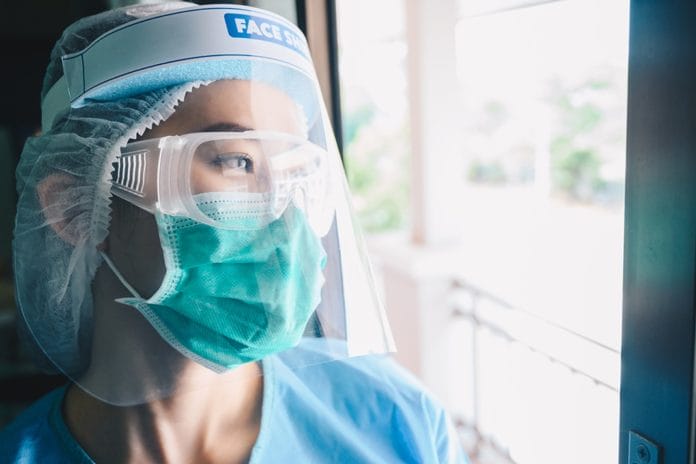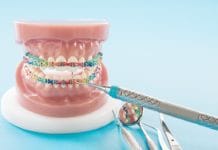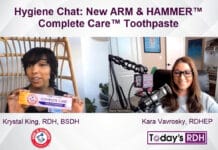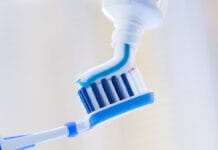Editor’s Note: Information about COVID-19 is changing on a daily, sometimes hourly, basis. We have made every attempt to ensure this article is up-to-date at the time of publication (May 26, 2020), but with the rapid changes occurring, some information may have changed since publication. Please visit https://www.coronavirus.
Article updated August 4, 2020 to reflect updated CDC Guidelines.
The anticipation seemed to be over when the Centers for Disease Control and Prevention (CDC) released its long-awaited guidelines for dental settings in response to the COVID-19 pandemic. Although the CDC has set up a framework for dental healthcare providers, it is encouraged to consult state dental boards and state health departments to stay current on local requirements. These will vary due to the different rates of infection throughout the country.
The risk associated with treating patients during the pandemic is directly associated with aerosols produced during procedures. The CDC states that surgical masks protect mucous membranes from droplet spatter, but they do not provide protection from the inhalation of infectious agents. Currently, there are no studies that assess the risk of contracting SARS-CoV-2 from dental procedures.
Stay Informed
It is imperative to monitor trends in your area for any changes in the number of cases, which would lead to needing to alter practice protocol. The CDC provides a source that is updated daily with trends that should be followed. Listed in the data are confirmed and probable cases. Confirmed cases are cases that meet confirmatory laboratory evidence, while probable cases are less definitive and use multiple factors for determination. The factors used for determining a probable case include a combination of meeting clinical criteria, epidemiological evidence, meeting presumptive laboratory evidence, or meeting vital records criteria.
The accuracy of the provided data is largely dependent on state and local public health departments. The exact numbers are difficult to report because not everyone that is infected gets tested as well as delays in reporting and testing. Therefore, data reported by the individual state should be assumed as the most accurate.1,2,3
Crisis Standards of Care
Before offering elective services, dental healthcare providers must ensure they are operating without the “crisis standards of care” in place. Crisis standards of care are defined as “a substantial change in usual healthcare operations and the level of care it is possible to deliver, which is made necessary by a pervasive (e.g., pandemic influenza) or catastrophic (e.g., earthquake, hurricane) disaster.
This change in the level of care delivered is justified by specific circumstances and is formally declared by a state government in recognition that crisis operations will be in effect for a sustained period. The formal declaration that crisis standards of care are in operation enables specific legal/regulatory powers and protections for healthcare providers in the necessary tasks of allocating and using scarce medical resources and implementing alternate care facility operations.”4
Crisis standard of care is implemented when there is a need to conserve limited resources, such as PPE, as well as to allow all individuals access to care by reducing the number of patients in the hospital for elective procedures.6
By staying abreast of that status of crisis standard of care conditions, practice owners can determine when to resume elective procedures.1
Screening and Patient Management
The CDC is recommending actively screening for fever and symptoms of COVID-19, regardless of the level of community spread currently in your area. If your community is experiencing minimal transmission and the patient does not present with symptoms, strictly adhering to standard precautions is acceptable. However, due to the nature of the virus and the documented spread by asymptomatic and pre-symptomatic carriers, it is strongly advised to adhere to following more stringent protocol described below.
Contact patients via telephone prior to appointments. Telephone triage will help determine if the patient has any symptoms that would require the appointment to be rescheduled. This also gives the facility the opportunity to encourage patients to limit the number of visitors accompanying them, as well as advising the patient that they and anyone accompanying them will be requested to wear a face covering upon entering the facility.
This telephone call also gives the facility the opportunity to prepare the patient for the changes they will see at their appointment, including routine temperature checks. This may help avoid confusion and upsetting the patient.
Upon arrival, all patients should be screened with a questionnaire and temperature check. Patients who pass the screening questionnaire and are afebrile (defined by the CDC as temperature <100.4o F) may be provided with dental care using appropriate engineering, administrative, and infection control considerations that will be discussed later.
August 4, 2020, the CDC updated language regarding screening anyone entering the facility. Proper documentation of the absence of symptoms of COVID-19 is recommended. Fever is measured > 100.0o F or subjective fever. Before allowing anyone to enter the facility, ask if they have been advised to self-quarantine due to exposure to someone with SARS-CoV-2 infection. If a patient is found to be febrile or displays any signs and symptoms of COVID-19, or experienced exposure that would warrant self-quarantine, dental health care providers should follow all precautions recommended in Section 2 Recommended IPC practices when providing dental healthcare for a patient with suspected or confirmed SARS-Cov-2 infection. Anyone that has ended home isolation after being diagnosed with COVID-19 can receive dental care following standard precautions.
Upon departure, it is recommended that patients put on their face covering as they leave the treatment area and make their way out of the facility. Even with extensive screening practices, there is a possibility that a patient may develop symptoms after dental treatment. Advise patients to contact the facility if they develop symptoms within 14 days of their appointment.1
Facility Considerations
Taking extra steps to ensure patient and staff safety is simple and, in some cases, provide helpful reminders to reduce the spread of COVID-19. The CDC recommends providing posters on proper hand hygiene, respiratory hygiene, and cough etiquette in strategic locations. Additionally, it is recommended to provide hand hygiene and respiratory hygiene stations with alcohol-based hand rub (60% to 95% alcohol), tissues, and no-touch trash receptacles at entrances, patient check-in areas, and waiting rooms.
Installation of physical barriers at reception areas to reduce contact with potentially infectious patients is recommended. If patients will be utilizing the waiting room, chairs should be a minimum of six feet apart. All objects that cannot be regularly disinfected should be removed from the waiting area, such as magazines, toys, video game controllers, or any other object that may be frequently touched.
Minimize the number of patients waiting in the waiting room. This can be accomplished by having patients wait in their vehicles or by staggering appointment times.1
Equipment Considerations
Equipment may require maintenance after prolonged office closures and non-use. Two such pieces of equipment that should be evaluated are dental unit waterlines and autoclaves. Test water quality to ensure safety prior to performing dental procedures. Water quality should meet the standards of the EPA for safe drinking water. Contact the manufacturer of the dental unit to determine if there is a need to shock the water lines prior to use. As always, continue standard maintenance and monitoring of dental unit waterlines.
Confirm all routine cleaning and maintenance has been done according to the manufacturer’s recommendations on all equipment used for cleaning and sterilizing instruments. Test sterilizers using a biologic indicator per the manufacturer’s instructions for use prior to reopening.1
Administrative Controls and Work Practices
Recommendations for work practice and administrative controls in an effort to reduce the spread of COVID-19 include limiting the number of patients in the facility, avoiding aerosol-generating procedures, and taking specific precautions when they are necessary, limiting the supplies and instruments accessibility, as well as using pre-procedural mouth rinses.
The CDC recommends limiting clinical treatment to one patient at a time when possible. When treating and setting up operatories for treatment, all supplies not necessary for the procedure should be covered or put away in drawers and cabinets.
Any supplies or instruments exposed during the procedure are to be considered contaminated and must be disposed of or reprocessed properly. This means clear all counter space of any items. For example, place gloves in a drawer, and mouth rinses and cups for rinsing should be in a cabinet. Note pads and pens should be stored in a drawer until needed. Only items needed for the procedure should be readily accessible.
Reducing aerosols is particularly important. The CDC recommends avoiding aerosol-producing procedures whenever possible. This includes avoiding the use of handpieces, air/water syringes, and ultrasonic scalers. Prioritize treatment to minimally invasive procedures that are done using hand instruments only.
If an aerosol-producing procedure is necessary, use four-handed dentistry, high volume evacuation, and dental dams to reduce the number of aerosols produced. Additionally, only the dental healthcare providers necessary for the procedure should be present in the operatory.
Pre-procedural mouth rinses with an antimicrobial product are also recommended, with the caveat that there is no published evidence regarding the effectiveness of a pre-procedural mouth rinse in reducing viral load of SARS-CoV-2.1
Engineering Controls
Recommended engineering controls include ventilation systems, strategic patient placement, and controlled patient volume. Considerations regarding patient volume should include determining the maximum number of patients who can safely receive care. When making this determination, it is important to factor in the layout of the facility, the number of rooms, and the amount of time needed to properly disinfect operatories.
Ideally, patient placement is best in individual rooms; however, open floor plans are quite popular in dental settings, which will require other considerations when placing patients for treatment. Facilities with open floor plans should strategically place patients at least six feet apart, orient operatories parallel to the direction of airflow when possible, and provide physical barriers.
Physical barriers are important when using portable HEPA air filtration systems. Physical barriers should be easy to clean and be floor to ceiling length. Additionally, if possible, patients’ heads should be placed near the return air vents and away from people passing by in the halls. In vestibule type operatories, placing the patients head towards the wall is recommended, if feasible.
Finally, properly maintaining ventilation systems is an important part of engineering controls. Check the direction of airflow of the facility’s ventilation system. Ideally, the airflow should move from a clean area to a contaminated area. If it does not, it is encouraged to adjust or install and maintain this direction of air movement. Consult with a heating, ventilation, and air conditioning professional to discuss increasing filtration efficacy, as well as the possibility to increase outdoor air supplied via the HVAC system.
A few other considerations listed were portable HEPA air filtration systems and upper-room ultraviolet germicidal irradiation (UVGI). Portable HEPA filtration systems reduce particle count and will reduce turnover time of operatories. The HEPA units should be placed close to the patient chair, but not behind the clinician, this is to ensure the airflow is not pulled into or past the breathing zone of the clinician.
The germicidal effect of UV light was first discovered in the late 19th century. Since its discovery, it has been found effective in improving air quality by reducing airborne pathogens. It has been recommended by the CDC for use in preventing the spread of tuberculosis in isolation rooms for several years. UVGI makes it possible to disinfect a large volume of air without overexposing people to UVC. It has a low initial and running cost, which is a huge benefit as well.1,6
June 17, 2020, the CDC updated language regarding engineering controls. The CDC clarified that they do not provide guidance on the decontamination of building heating, ventilation, and air conditioning (HVAC) systems potentially exposed to SARS-CoV-2. The CDC update goes on to say, “To date, CDC has not identified confirmatory evidence to demonstrate that viable virus is contaminating these systems.”1
Hand Hygiene and Universal Source Control
Hand hygiene has always been important in a dental setting, now more than ever. It is crucial to brush up on proper hand hygiene to keep clinicians and patients safe. You can view detailed instructions for hand hygiene here. Hand hygiene should be practiced before and after contact with patients, after contact with any possible infectious materials, as well as before and after donning PPE.
Facilities should ensure hand hygiene supplies are readily available at every care location in the facility.
As a part of source control efforts, the CDC recommends all dental healthcare providers wear a mask in the dental setting. Cloth masks are acceptable for employees that do not require PPE. Employees that do require PPE may wear cloth masks when not engaged with patient care and when leaving the facility at the end of the day.
If a dental healthcare provider touches their mask, they must perform hand hygiene immediately before and after. Face masks should be changed if they become soiled, damp, or hard to breathe through. Cloth face coverings should be laundered daily.1
Personal Protective Equipment (PPE)
First and foremost, the CDC states regarding PPE, “Ensure that you have the appropriate amount of personal protective equipment (PPE) and supplies to support your patient volume. If PPE and supplies are limited, prioritize dental care for the highest need, most vulnerable patients first.” Employers can refer to the OSHA PPE standards to determine appropriate PPE for employees.
In summary, the OSHA PPE standards include the following guidelines also found on the CDC website. Dental facilities are required to make certain that all reusable PPE is thoroughly cleaned, decontaminated, and stored between uses.
During procedures likely to produce splashing or spattering, dental healthcare providers should wear “a surgical mask, eye protection (goggles, protective eyewear with solid side shields, or a full-face shield), and a gown or protective clothing.” During procedures that produce aerosols, dental healthcare providers should consider using an N95 respirator (this includes aerosol-producing procedures on patients assumed to be noncontagious). Other options include disposable filtering facepiece respirators, PAPRs, or elastomeric respirators.
August 4, 2020, the CDC updated language regarding eye protection stating “protective eyewear with gaps between the glasses and face likely do not protect the eyes from splashes and sprays.” In areas of moderate to substantial community spread, the CDC recommends the use of universal eye protection during patient encounters including those where splashes and sprays are not anticipated.
If none of these are available, use of a surgical mask and a full-face shield is recommended. The CDC states, “If a surgical mask and a full-face shield are not available, do not perform any aerosol-generating procedures.”
Employers should review and document proper donning and doffing techniques with staff. Each facility should have written policies and procedures for safely donning and doffing PPE. There are multiple sources that can be used; detailed steps can be found here.1
PPE Optimization Strategies
During the COVID-19 pandemic, suppliers have reported shortages of PPE, particularly masks and respirators. With this in mind, the CDC has developed a series of strategies or options to optimize supplies of PPE as well as a burn calculator to help facilities determine the rate at which they use PPE items. This can help with strategies to optimize the use of PPE during the shortage associated with COVID-19.
It is important to note, these strategies are only intended to remain in place during shortages of PPE. These strategies are tiered and sequential; therefore, reviewing and understanding the sequence is imperative.
An example used by the CDC regarding extended use of masks and respirators states the only time this should be done is if all applicable administrative and engineering controls have been implemented. This would include selectively canceling elective and nonurgent procedures, the guidelines for extended use of PPE is not meant to encourage facilities to practice at normal capacity during a PPE shortage.1,7,8
Environmental Infection Control
The procedures for environmental cleaning and disinfecting of surfaces has not changed drastically in the face of the pandemic. The guideline for infection control in a dental setting (2003) provided by the CDC should still be followed.
The difference is in the time elapsed between when the patient exits the operatory to when the dental healthcare provider should proceed to clean and disinfect the area. For patients NOT suspected of being infected with COVID-19, the initial guidelines released May 18, 2020, stated dental healthcare provider should wait 15 minutes after dismissing the patient and before re-entering the operatory to clean and disinfect the area. As of June 17, 2020, the guidelines for wait time has been revised; there is no longer a recommendation to wait 15 minutes prior to cleaning and disinfecting the operatory.1
If a patient is seen that is suspected of being infected with COVID-19, the time elapses may vary depending on the rate of air changes per hour of the facilities HVAC system. For example, if the facility’s rate change per hour is 8, the time required for 99% efficacy for removal is 35 minutes; for 99.9% efficacy for removal, the time elapse would be 52 minutes.
The EPA only recommends the use of disinfectants on List N for use against SARS-CoV-2. No other alternative disinfecting methods have been shown effective against SARS-CoV-2. This includes ultrasonic waves and LED blue light. Additionally, the EPA does not routinely review these methods; therefore, they cannot confirm the safety or efficacy of these types of methods.
The management of laundry and medical waste should continue to follow policies previously implemented.1,9,10
Additional Precautions for Patients with Suspected or Confirmed Infection of COVID-19
Patients who arrive at your facility with suspected infection should be rescheduled. If the patient does not present with severe symptoms, advise the patient to return home and contact their primary physician. If the patient presents with severe symptoms such as shortness of breath, send the patient to a medical facility or call EMS.
If emergency care is necessary for a patient with a confirmed infection with COVID-19, special precautions are required. Treatment should be performed in an enclosed room with no other patients scheduled at that time, preferably at the end of the day. Avoid aerosol-producing procedures if possible. If aerosol-producing procedures are necessary treatment should be performed in an airborne infection isolation room.
The initial guideline for determining the infectious period of a patient, visitor, or healthcare provider with confirmed COVID-19 was 10 days after the exposure. This guideline has been updated, as of June 17, 2020, from the time an individual is exposed to COVID-19, the individual is to be considered infectious two days after exposure. Therefore, patients and employees must notify the dental clinic if they develop symptoms or test positive within two days of their dental appointment. This updated time will help contact tracing accuracy; it also aligns with recommendations of the WHO, European CDC, and Health Canada.1
For the complete list of recommendations refer to the CDC’s Interim Infection Prevention and Control Recommendations for Patients with Suspected or Confirmed Coronavirus Disease 2019 (COVID-19) in Healthcare Settings.1,11
Test-Based Strategies and Monitoring Dental Healthcare Providers
Facilities may want to implement pre-procedure testing for COVID-19. This can help better determine what level of PPE is necessary, helping to conserve PPE and preventing further shortages. However, this is not a foolproof method to determine risk. Some tests can produce false negatives. Another consideration is the time it takes to administer tests and get results, As testing improves, more rapid and accurate tests may become available, making this a more important step in reducing the spread of COVID-19.
Facilities will need to implement strategies to monitor dental healthcare providers. This should include monitoring for fever and other symptoms. A policy should be put in place that encourages dental healthcare providers to stay home when feeling sick. These employees should be assured there will be no penalty when they need to stay home due to symptoms or fever.
August 4, 2020, the CDC updated language regarding monitoring and managing dental health care providers. If a dental health care provider suspects they have COVID-19 they should not come to work. They should notify their primary healthcare provider for guidance on the need for medical evaluation. Further information on the protocol for dental health care providers suspected or confirmed to have COVID-19 can be is available in the Interim Guidance on Criteria for Return to Work for Healthcare Personnel with Confirmed or suspected COVID-19.
Additional changes to language regarding physical distancing and possible exposure among co-workers state dental healthcare workers should remain six feet apart in all non-patient areas as well as areas where individuals take breaks, eat, and drink, especially when they must be unmasked.
If a dental healthcare provider becomes feverish or develops symptoms while at work, they should don a face covering, advise their supervisor, and leave work immediately. The CDC defines a fever in dental healthcare workers as >100.0o F.
Conclusion
Although these changes will certainly take time to get used to, it is especially important that we follow these guidelines. We all want what is best for our patients. We all vowed to “do no harm.” Ignoring or irresponsibly proceeding with care while not adhering to the CDC’s guidelines may lead to dental practices becoming a vector for this disease. If that were to happen, the public may see dentistry as a risk and avoid much-needed treatment.
Dentistry has fought tooth and nail to be considered an important part of overall health. Let’s continue to show our patients the importance as well as the lengths we will go to keep them safe. As more research emerges, including effective treatments and vaccines, these guidelines may change. As frustrating as it can be to try to keep up with an evolving situation, it is necessary.
Annual infection control CE classes should be required for all license renewals in the future, not only for the safety of our patients but for the safety of dental healthcare providers. If you are not required to take an annual infection control CE course, please consider doing it electively to stay informed on any changes that may follow this update.
Now Listen to the Today’s RDH Dental Hygiene Podcast Below:
References
- Centers for Disease Control and Prevention. Guidance for Dental Settings. Retrieved from https://www.cdc.gov/coronavirus/2019-ncov/hcp/dental-settings.html.
- Centers for Disease Control and Prevention. Framework for Healthcare Systems Providing Non-COVID-19 Clinical Care During the COVID-19 Pandemic. Retrieved from https://www.cdc.gov/coronavirus/2019-ncov/hcp/framework-non-COVID-care.html/.
- Centers for Disease Control and Prevention. Cases in the U.S. Retrieved from https://www.cdc.gov/coronavirus/2019-ncov/cases-updates/cases-in-us.html.
- Institute of Medicine (US) Forum on Medical and Public Health Preparedness for Catastrophic Events. Crisis Standards of Care: Summary of a Workshop Series. Washington (DC): National Academies Press (US); 2010. Related IOM Work on Crisis Standards of Care. Retrieved from https://www.ncbi.nlm.nih.gov/books/NBK32749/.
- Danna, D.M. Crisis Standards of Care: Are You Familiar? Society for the Advancement of Disaster Nursing. Retrieved from https://disasternursing.org/2018/09/01/crisis-standards-of-care-are-you-familiar/.
- Yang, Y., Chan, W.Y., Wu, C.L., Kong, R.Y., Lai, A.C. Minimizing the exposure of airborne pathogens by upper-room ultraviolet germicidal irradiation: an experimental and numerical study. J R Soc Interface. 2012; 9(77): 3184‐3195. doi:10.1098/rsif.2012.0439. Retrieved from https://royalsocietypublishing.org/doi/full/10.1098/rsif.2012.0439.
- Centers for Disease Control and Prevention. Strategies to Optimize the Supply of PPE and Equipment. Retrieved from https://www.cdc.gov/coronavirus/2019-ncov/hcp/ppe-strategy/index.html.
- Centers for Disease Control and Prevention. Personal Protective Equipment (PPE) Burn Rate Calculator. Retrieved from https://www.cdc.gov/coronavirus/2019-ncov/hcp/ppe-strategy/burn-calculator.html.
- Centers for Disease Control and Prevention. Environmental Infection Control Guidelines, Appendix B: Air. Retrieved from https://www.cdc.gov/infectioncontrol/guidelines/environmental/appendix/air.html#tableb1.
- United States Environmental Protection Agency. List N: Disinfectants for use Against SARS-CoV-2. Retrieved from https://www.epa.gov/pesticide-registration/list-n-disinfectants-use-against-sars-cov-2.
- Centers for Disease Control and Prevention. Interim Infection Prevention and Control Recommendations for Patients with Suspected or Confirmed Coronavirus Disease (COVID-19) in Healthcare Settings. Retrieved from https://www.cdc.gov/coronavirus/2019-ncov/hcp/infection-control-recommendations.html.
















